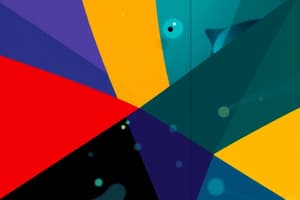Podcast
Questions and Answers
What is the primary focus of the first chapter?
What is the primary focus of the first chapter?
- Sums and integrals
- Differential equations
- Matrices and vectors (correct)
- Complex numbers
The Nash bargaining problem is an example of constrained optimisation.
The Nash bargaining problem is an example of constrained optimisation.
True (A)
What is the function of an implicit function theorem?
What is the function of an implicit function theorem?
To show conditions under which a relation defines a function.
The _____ theorem of calculus connects differentiation and integration.
The _____ theorem of calculus connects differentiation and integration.
Match the following concepts with their correct applications:
Match the following concepts with their correct applications:
Which of the following is NOT a type of function discussed in the content?
Which of the following is NOT a type of function discussed in the content?
All integrals are finite.
All integrals are finite.
What is required for the prices ATq to be more attractive than market prices?
What is required for the prices ATq to be more attractive than market prices?
In a zero sum game, the sum of the payoffs to both players is always positive.
In a zero sum game, the sum of the payoffs to both players is always positive.
What is the purpose of shadow prices in linear programming?
What is the purpose of shadow prices in linear programming?
A two person ___ game is one where whatever one player wins, the other loses.
A two person ___ game is one where whatever one player wins, the other loses.
Match the concepts to their definitions:
Match the concepts to their definitions:
What does the input vector y represent in the production process?
What does the input vector y represent in the production process?
The price vector p lists the sales prices of the commodities only.
The price vector p lists the sales prices of the commodities only.
What is the primary goal of the baker in the linear programming problem?
What is the primary goal of the baker in the linear programming problem?
The constraints in the baker's linear programming problem require that x must not be less than ____.
The constraints in the baker's linear programming problem require that x must not be less than ____.
Match the following concepts with their definitions:
Match the following concepts with their definitions:
In a linear programming problem, what does the notation Ax refer to?
In a linear programming problem, what does the notation Ax refer to?
A baker can freely choose the quantity x of baked goods without any constraints.
A baker can freely choose the quantity x of baked goods without any constraints.
What is the dual problem relating to the baker's production?
What is the dual problem relating to the baker's production?
The equation for revenue generated from selling x is expressed as ____.
The equation for revenue generated from selling x is expressed as ____.
What represents the maximum revenue achievable by the baker?
What represents the maximum revenue achievable by the baker?
What is the result of scalar multiplying a matrix A by a scalar c?
What is the result of scalar multiplying a matrix A by a scalar c?
A matrix with 3 rows and 2 columns is called a 2 × 3 matrix.
A matrix with 3 rows and 2 columns is called a 2 × 3 matrix.
What is the notation used to express the entry in the second row and first column of a matrix C?
What is the notation used to express the entry in the second row and first column of a matrix C?
A _____ matrix is obtained by adding corresponding entries of two matrices.
A _____ matrix is obtained by adding corresponding entries of two matrices.
Match the following operations with their descriptions:
Match the following operations with their descriptions:
If matrix C is a 2 × 3 matrix and matrix D is also a 2 × 3 matrix, what will be the dimensions of the resulting matrix when C is added to D?
If matrix C is a 2 × 3 matrix and matrix D is also a 2 × 3 matrix, what will be the dimensions of the resulting matrix when C is added to D?
The scalars used in matrix operations can only be real numbers.
The scalars used in matrix operations can only be real numbers.
How does one denote the zero matrix?
How does one denote the zero matrix?
A matrix with m rows and n columns is referred to as an _____ matrix.
A matrix with m rows and n columns is referred to as an _____ matrix.
What does the vector product of two vectors u and v represent in a geometric context?
What does the vector product of two vectors u and v represent in a geometric context?
The direction of the vector product v × u is the same as u × v.
The direction of the vector product v × u is the same as u × v.
What is the formula for the area of the parallelogram formed by vectors u and v?
What is the formula for the area of the parallelogram formed by vectors u and v?
The vector product, also known as the ______, is defined as the vector orthogonal to both u and v.
The vector product, also known as the ______, is defined as the vector orthogonal to both u and v.
Match the following terms with their definitions:
Match the following terms with their definitions:
Which formula correctly gives the area of the parallelepiped formed by vectors u, v, and w?
Which formula correctly gives the area of the parallelepiped formed by vectors u, v, and w?
The expression for the vector product can be simplified using determinants.
The expression for the vector product can be simplified using determinants.
What is the significance of the right hand rule in vector products?
What is the significance of the right hand rule in vector products?
The length of the vector product u × v is equal to the modulus of the ______.
The length of the vector product u × v is equal to the modulus of the ______.
Which of the following statements about the equations of a plane is true?
Which of the following statements about the equations of a plane is true?
Flashcards
ISBN
ISBN
International Standard Book Number. A unique 13-digit number used to identify books worldwide.
Linear Programming
Linear Programming
A mathematical technique used for optimizing a linear objective function subject to linear constraints.
Quadric Surfaces
Quadric Surfaces
3D surfaces described by quadratic equations. Examples include spheres, paraboloids, and hyperboloids.
Tangent Plane
Tangent Plane
Signup and view all the flashcards
Gradient
Gradient
Signup and view all the flashcards
Positive/Negative Definite (Quadratic Forms)
Positive/Negative Definite (Quadratic Forms)
Signup and view all the flashcards
Constrained Optimisation
Constrained Optimisation
Signup and view all the flashcards
Matrix
Matrix
Signup and view all the flashcards
m × n matrix
m × n matrix
Signup and view all the flashcards
Scalar
Scalar
Signup and view all the flashcards
Scalar Multiplication
Scalar Multiplication
Signup and view all the flashcards
Matrix Addition
Matrix Addition
Signup and view all the flashcards
Matrix Subtraction
Matrix Subtraction
Signup and view all the flashcards
Zero Matrix
Zero Matrix
Signup and view all the flashcards
Additive Identity
Additive Identity
Signup and view all the flashcards
Matrix Equation
Matrix Equation
Signup and view all the flashcards
Dual Problem
Dual Problem
Signup and view all the flashcards
Shadow Prices
Shadow Prices
Signup and view all the flashcards
Zero-Sum Game
Zero-Sum Game
Signup and view all the flashcards
Payoff Matrix
Payoff Matrix
Signup and view all the flashcards
Mixed Strategies
Mixed Strategies
Signup and view all the flashcards
Vector product
Vector product
Signup and view all the flashcards
Plane equation
Plane equation
Signup and view all the flashcards
Right-hand rule
Right-hand rule
Signup and view all the flashcards
Normal vector
Normal vector
Signup and view all the flashcards
Parallelogram area
Parallelogram area
Signup and view all the flashcards
Determinant (2x2)
Determinant (2x2)
Signup and view all the flashcards
Parallelepiped volume
Parallelepiped volume
Signup and view all the flashcards
Cartesian equation of a plane
Cartesian equation of a plane
Signup and view all the flashcards
Vector equation of a plane
Vector equation of a plane
Signup and view all the flashcards
Geometric interpretation of a determinant
Geometric interpretation of a determinant
Signup and view all the flashcards
What is a price vector?
What is a price vector?
Signup and view all the flashcards
How is the value of a commodity bundle calculated?
How is the value of a commodity bundle calculated?
Signup and view all the flashcards
What is a hyperplane?
What is a hyperplane?
Signup and view all the flashcards
How is the revenue from selling a baked good calculated?
How is the revenue from selling a baked good calculated?
Signup and view all the flashcards
What is the constraint in the baker's problem?
What is the constraint in the baker's problem?
Signup and view all the flashcards
What is a linear programming problem?
What is a linear programming problem?
Signup and view all the flashcards
What is the dual problem in the context of the baker's problem?
What is the dual problem in the context of the baker's problem?
Signup and view all the flashcards
How does the dual problem relate to the baker's revenue?
How does the dual problem relate to the baker's revenue?
Signup and view all the flashcards
Study Notes
Matrices and Vectors
- A matrix is a rectangular array of numbers, used for systematic calculations.
- An m × n matrix has m rows and n columns.
- Entries are called scalars, usually real numbers.
- Scalar multiplication multiplies each entry of a matrix by a scalar.
- Matrix addition adds corresponding entries.
- Matrix subtraction subtracts corresponding entries.
- The zero matrix has all entries equal to zero.
- Vectors can be represented in 2D, 3D and n dimensions.
- Lines and planes can be represented using vectors.
- The vector product (or cross product) is orthogonal to both vectors.
- The area of a parallelogram is given by the magnitude of the vector product.
- Determinants of 2x2 and 3x3 matrices can represent areas and volumes respectively.
- Commodity bundles, linear production models, price vectors, and linear programming examples are mentioned.
Functions of One Variable
- Functions of one variable can be elementary functions (power, exponential, trigonometric).
- Functions can be combined (sum, difference, product, quotient).
- Inverse functions reverse the action of a function.
- Derivatives are measures of instantaneous rate of change.
- Higher-order derivatives are successive derivatives.
- Taylor series approximates a function using derivatives.
- Conic sections (parabola, ellipse, hyperbola, circle) are described through implicit equations.
Functions of Several Variables
- Functions of two variables are defined, including linear and affine functions.
- Quadric surfaces are mentioned.
- Partial derivatives measure rate of change with respect to one variable (others held constant).
- Tangent planes approximate functions near a point.
- The gradient is a vector representing all the partial derivatives.
- Directional derivatives measure the rate of change along a specific direction.
- Functions of more than two variables are also discussed, including Tangent hyperplanes and Directional derivatives.
- Indifference curves, profit maximization, and contract curve applications are mentioned
Stationary Points
- Stationary points for single-variable functions are critical points.
- Optimization problems find the maximum or minimum of a function.
- Constrained optimisation involves finding the extrema of a function subject to constraints.
- The use of computer systems is suggested for calculations.
- Stationary points, gradients, and stationary points for functions of more than two variables are mentioned in general.
Vector Functions
- Vector-valued functions output vectors.
- Affine functions and flats relate to lines, planes, and higher-dimensional spaces.
- Derivatives of vector-valued functions are described.
- Chain rule applies to derivatives of composite functions.
- Second derivatives and a Taylor series for scalar valued functions of n variables are included in the study material.
Optimisation of Scalar Valued Functions
- Change of basis and quadratic forms are discussed.
- Definite matrices are mentioned.
- Applications include the Nash bargaining problem, inventory control, least squares analysis, Kuhn–Tucker conditions, linear programming, and saddle points.
Inverse Functions
- Local inverses of scalar-valued functions are shown in detail, and their differentiability.
- Inverse trigonometric functions are discussed.
- Local inverses of vector-valued functions, coordinate systems (e.g., polar coordinates), differential operators are also included.
Implicit Functions
- Implicit differentiation is explained.
- Implicit functions, Implicit function theorem, and shadow prices are presented.
Differentials
- Matrix algebra and linear systems are mentioned.
- Differentials are used to approximate small changes in a function.
- Applications include Slutsky equations.
Sums and Integrals
- Sums, integrals, fundamental theorem of calculus, notations, and standard integrals are explained.
- Techniques like partial fractions, completing the square, change of variables, and integration by parts are included.
- Infinite sums and integrals, dominated convergence, differentiating integrals, power series are included in this chapter.
- This chapter also covers applications like Probability, probability density functions, binomial distribution, Poisson distribution, Normal distribution, and sums of random variables.
Multiple Integrals
- Repeated integrals evaluate multidimensional integrals over intervals.
- Applications such as Joint probability distributions, Marginal probability distributions, Expectation, Variance, Covariance, Independent random variables, Generating functions, and Multivariate normal distributions are mentioned.
Differential Equations of Order One
- Differential equations and their solutions are explained.
- General solutions and boundary conditions of ordinary equations.
- Separable, exact, linear, homogeneous equations, and related solutions are included.
- Partial differential equations, exact equations, and change of variable in partial differential equations are included in this section.
Complex Numbers
- Complex numbers and their use in solving quadratic equations are discussed.
- Modulus, argument, complex roots, and polynomials are included in this section.
- Applications like Characteristic functions and Central limit theorem are discussed.
Linear Differential and Difference Equations
- Linear differential equations and difference equations, their methods of solutions, linear operators, and convergence, along with corresponding applications.
- Applications include Cobweb models, Gambler’s ruin, Systems of linear equations.
Studying That Suits You
Use AI to generate personalized quizzes and flashcards to suit your learning preferences.




